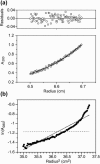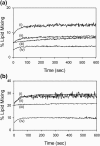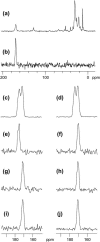Oligomeric beta-structure of the membrane-bound HIV-1 fusion peptide formed from soluble monomers
- PMID: 15345571
- PMCID: PMC1304598
- DOI: 10.1529/biophysj.103.028530
Oligomeric beta-structure of the membrane-bound HIV-1 fusion peptide formed from soluble monomers
Abstract
The human immunodeficiency virus type 1 (HIV-1) fusion peptide serves as a useful model system for understanding viral/target cell fusion, at least to the lipid mixing stage. Previous solid-state NMR studies have shown that the peptide adopts an oligomeric beta-strand structure when associated with a lipid and cholesterol mixture close to that of membranes of host cells of the virus. In this study, this structure was further investigated using four different peptide constructs. In aqueous buffer solution, two of the constructs were primarily monomeric whereas the other two constructs had significant populations of oligomers/aggregates. NMR measurements for all membrane-associated peptide constructs were consistent with oligomeric beta-strand structure. Thus, constructs that are monomeric in solution can be converted to oligomers as a result of membrane association. In addition, samples prepared by very different methods had very similar NMR spectra, which indicates that the beta-strand structure is an equilibrium rather than a kinetically trapped structure. Lipid mixing assays were performed to assess the fusogenicities of the different constructs, and there was not a linear correlation between the solution oligomeric state and fusogenicity. However, the functional assays do suggest that small oligomers may be more fusogenic than either monomers or large aggregates.
Figures



Similar articles
-
Solid-state nuclear magnetic resonance evidence for parallel and antiparallel strand arrangements in the membrane-associated HIV-1 fusion peptide.Biochemistry. 2003 Oct 14;42(40):11879-90. doi: 10.1021/bi0348157. Biochemistry. 2003. PMID: 14529300
-
Solid-state nuclear magnetic resonance evidence for an extended beta strand conformation of the membrane-bound HIV-1 fusion peptide.Biochemistry. 2001 Jul 10;40(27):8126-37. doi: 10.1021/bi0100283. Biochemistry. 2001. PMID: 11434782
-
HIV fusion peptide and its cross-linked oligomers: efficient syntheses, significance of the trimer in fusion activity, correlation of beta strand conformation with membrane cholesterol, and proximity to lipid headgroups.Biochemistry. 2009 Jan 20;48(2):289-301. doi: 10.1021/bi8015668. Biochemistry. 2009. PMID: 19093835 Free PMC article.
-
Synthesis, enhanced fusogenicity, and solid state NMR measurements of cross-linked HIV-1 fusion peptides.Biochemistry. 2003 Apr 1;42(12):3527-35. doi: 10.1021/bi027052g. Biochemistry. 2003. PMID: 12653557
-
Conformational flexibility and strand arrangements of the membrane-associated HIV fusion peptide trimer probed by solid-state NMR spectroscopy.Biochemistry. 2006 Oct 31;45(43):12960-75. doi: 10.1021/bi0615902. Biochemistry. 2006. PMID: 17059213 Free PMC article.
Cited by
-
Solid-state nuclear magnetic resonance measurements of HIV fusion peptide to lipid distances reveal the intimate contact of beta strand peptide with membranes and the proximity of the Ala-14-Gly-16 region with lipid headgroups.Biochemistry. 2007 May 1;46(17):4997-5008. doi: 10.1021/bi6024808. Epub 2007 Apr 7. Biochemistry. 2007. PMID: 17417873 Free PMC article.
-
Identification of the Fusion Peptide-Containing Region in Betacoronavirus Spike Glycoproteins.J Virol. 2016 May 27;90(12):5586-5600. doi: 10.1128/JVI.00015-16. Print 2016 Jun 15. J Virol. 2016. PMID: 27030273 Free PMC article.
-
2H nuclear magnetic resonance spectroscopy supports larger amplitude fast motion and interference with lipid chain ordering for membrane that contains β sheet human immunodeficiency virus gp41 fusion peptide or helical hairpin influenza virus hemagglutinin fusion peptide at fusogenic pH.Biochim Biophys Acta Biomembr. 2020 Oct 1;1862(10):183404. doi: 10.1016/j.bbamem.2020.183404. Epub 2020 Jun 23. Biochim Biophys Acta Biomembr. 2020. PMID: 32585207 Free PMC article.
-
Structure and plasticity of the human immunodeficiency virus gp41 fusion domain in lipid micelles and bilayers.Biophys J. 2007 Aug 1;93(3):876-85. doi: 10.1529/biophysj.106.102335. Epub 2007 May 18. Biophys J. 2007. PMID: 17513369 Free PMC article.
-
Structure, topology, and tilt of cell-signaling peptides containing nuclear localization sequences in membrane bilayers determined by solid-state NMR and molecular dynamics simulation studies.Biochemistry. 2007 Jan 30;46(4):965-75. doi: 10.1021/bi061895g. Biochemistry. 2007. PMID: 17240980 Free PMC article.
References
-
- Afonin, S., R. W. Glaser, M. Berditchevskaia, P. Wadhwani, K. H. Guhrs, U. Mollmann, A. Perner, and A. S. Ulrich. 2003. 4-Fluorophenylglycine as a label for 19F NMR structure analysis of membrane-associated peptides. ChemBioChem. 4:1151–1163. - PubMed
-
- Balbach, J. J., J. Yang, D. P. Weliky, P. J. Steinbach, V. Tugarinov, J. Anglister, and R. Tycko. 2000. Probing hydrogen bonds in the antibody-bound HIV-1 gp120 V3 loop by solid state NMR REDOR measurements. J. Biomol. NMR. 16:313–327. - PubMed
-
- Bennett, A. E., C. M. Rienstra, M. Auger, K. V. Lakshmi, and R. G. Griffin. 1995. Heteronuclear decoupling in rotating solids. J. Chem. Phys. 103:6951–6958.
Publication types
MeSH terms
Substances
Grants and funding
LinkOut - more resources
Full Text Sources

